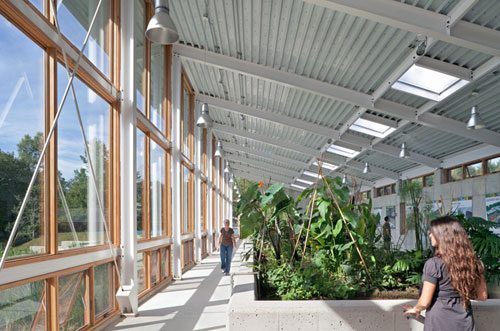Live | Build | Sustain
Furthermore, the matrix allows the Challenge to employ a mechanism called "scale jumping," in which a project may be exempted from meeting certain imperatives (such as net-zero water or net-zero energy) within its boundaries. However, the team must demonstrate that the overall goal of the imperative can be achieved by implementing solutions at the campus, neighborhood, or community scale.
Recognizing that the program is still evolving, the developers have also included temporary exceptions to many of the imperatives. Once the market successfully responds to an imperative's demands, these exceptions will be removed. Typically, a project team can take advantage of an exception by demonstrating that it has made every effort to meet the requirement and has advocated some kind of industrywide change. Examples of such advocacy include writing manufacturers to request modifications in material sourcing, product formulation, or assembly, or by filing an appeal with the appropriate agencies to amend a code.
The process
To formally participate in the Challenge, at least one member of the project team must join ILBI's Living Building Community. Membership, which is available to any interested individual or organization according to a tiered fee schedule (currently $125 for an individual), offers access to various online resources, from the actual user's guide to discussion forums. According to Eden Brukman, ILBI vice president and research director for Cascadia, there are currently more than 475 members.
 |
The Omega Center for Sustainable Living in Rhinebeck, New York, was completed in May 2009. The building, designed by BNIM Architects, houses a classroom and an Eco-Machine, which treats wastewater with algae, fungi, bacteria, plants, snails, and fish. Photo: © Farshid Assassi |
Â
To officially participate in the Challenge - and obtain any needed clarifications from ILBI - a member must register the proposed project for an additional fee, ranging from $100 to $500, based on type. Brukman estimates that 70 projects in North America and a handful in Europe and Australia are registered under some version of the Challenge, although she has heard anecdotally about many more unregistered projects informally trying to meet the program's criteria.
The actual certification requires a third fee. A payment starting at $1,000 for projects less than 500 square meters and aiming for full certification is due prior to an audit, which takes place after the project has been in operation one full year. According to Brukman, ILBI will select people with a knowledge of green building and train them to undertake these audits. They will function as consultants to ILBI rather than employees and will visit the site and review the various metrics and documentation submitted by the team.
The imperatives for all petals must be met for full certification, or "Living Building" status. If at least three petals are met, including at least one being the energy, water, or materials petal, the project will earn partial certification, or "petal recognition." The team can later apply for full certification, if and when it fulfills the remaining petals.









